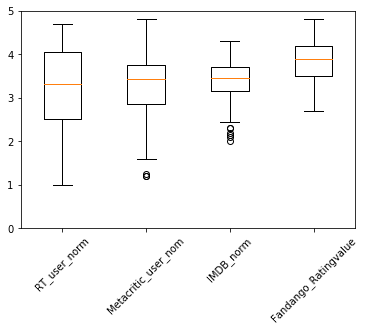import pandas as pd
import matplotlib.pyplot as plt
reviews = pd.read_csv('fandango_scores.csv')
cols = ['FILM', 'RT_user_norm', 'Metacritic_user_nom', 'IMDB_norm', 'Fandango_Ratingvalue']
norm_reviews = reviews[cols]
print(norm_reviews[:5])
FILM RT_user_norm Metacritic_user_nom
0 Avengers: Age of Ultron (2015) 4.3 3.55
1 Cinderella (2015) 4.0 3.75
2 Ant-Man (2015) 4.5 4.05
3 Do You Believe? (2015) 4.2 2.35
4 Hot Tub Time Machine 2 (2015) 1.4 1.70
IMDB_norm Fandango_Ratingvalue
0 3.90 4.5
1 3.55 4.5
2 3.90 4.5
3 2.70 4.5
4 2.55 3.0
fandango_distribution = norm_reviews['Fandango_Ratingvalue'].value_counts()
print(fandango_distribution)
fandango_distribution = fandango_distribution.sort_index()
print('-----------')
print(fandango_distribution)
imdb_distribution = norm_reviews['IMDB_norm'].value_counts()
print(imdb_distribution)
imdb_distribution = imdb_distribution.sort_index()
print("-----------")
print(imdb_distribution)
4.1 16
4.2 12
3.9 12
4.3 11
3.7 9
3.5 9
4.5 9
3.4 9
3.6 8
4.4 7
4.0 7
3.2 5
2.9 5
3.8 5
3.3 4
4.6 4
3.0 4
4.8 3
3.1 3
2.8 2
2.7 2
Name: Fandango_Ratingvalue, dtype: int64
-----------
2.7 2
2.8 2
2.9 5
3.0 4
3.1 3
3.2 5
3.3 4
3.4 9
3.5 9
3.6 8
3.7 9
3.8 5
3.9 12
4.0 7
4.1 16
4.2 12
4.3 11
4.4 7
4.5 9
4.6 4
4.8 3
Name: Fandango_Ratingvalue, dtype: int64
3.60 10
3.30 9
3.15 9
3.90 9
3.70 8
3.45 7
3.55 7
3.35 7
3.75 6
3.20 6
2.75 5
3.65 5
3.50 4
2.70 4
3.05 4
4.10 4
3.25 4
3.85 4
3.80 3
2.95 3
2.60 2
4.20 2
2.45 2
2.30 2
3.95 2
2.80 2
3.00 2
4.00 1
3.10 1
2.00 1
2.50 1
2.85 1
4.05 1
4.15 1
2.20 1
4.30 1
2.55 1
2.15 1
3.40 1
2.90 1
2.10 1
Name: IMDB_norm, dtype: int64
-----------
2.00 1
2.10 1
2.15 1
2.20 1
2.30 2
2.45 2
2.50 1
2.55 1
2.60 2
2.70 4
2.75 5
2.80 2
2.85 1
2.90 1
2.95 3
3.00 2
3.05 4
3.10 1
3.15 9
3.20 6
3.25 4
3.30 9
3.35 7
3.40 1
3.45 7
3.50 4
3.55 7
3.60 10
3.65 5
3.70 8
3.75 6
3.80 3
3.85 4
3.90 9
3.95 2
4.00 1
4.05 1
4.10 4
4.15 1
4.20 2
4.30 1
Name: IMDB_norm, dtype: int64
fig, ax = plt.subplots()
# ax.hist(norm_reviews['Fandango_Ratingvalue'])
# ax.hist(norm_reviews['Fandango_Ratingvalue'],bins=20)
ax.hist(norm_reviews['Fandango_Ratingvalue'], range=(4, 5),bins=20)
plt.show()

fig = plt.figure(figsize=(5,20))
ax1 = fig.add_subplot(4,1,1)
ax2 = fig.add_subplot(4,1,2)
ax3 = fig.add_subplot(4,1,3)
ax4 = fig.add_subplot(4,1,4)
ax1.hist(norm_reviews['Fandango_Ratingvalue'], bins=20, range=(0, 5))
ax1.set_title('Distribution of Fandango Ratings')
ax1.set_ylim(0, 50)
ax2.hist(norm_reviews['RT_user_norm'], bins=20, range=(0, 5))
ax2.set_title('Distribution of Rotten Tomatoes Ratings')
ax2.set_ylim(0, 50)
ax3.hist(norm_reviews['Metacritic_user_nom'], 20, range=(0, 5))
ax3.set_title('Distribution of Metacritic Ratings')
ax3.set_ylim(0, 50)
ax4.hist(norm_reviews['IMDB_norm'], 20, range=(0, 5))
ax4.set_title('Distribution of IMDB Ratings')
ax4.set_ylim(0, 50)
plt.show()

fig, ax = plt.subplots()
ax.boxplot(norm_reviews['RT_user_norm'])
ax.set_xticklabels(['Rotten Tomatoes'])
plt.show()

num_cols = ['RT_user_norm', 'Metacritic_user_nom', 'IMDB_norm', 'Fandango_Ratingvalue']
fig, ax = plt.subplots()
ax.boxplot(norm_reviews[num_cols].values)
ax.set_xticklabels(num_cols,rotation=45)
ax.set_ylim(0,5)
plt.show()




